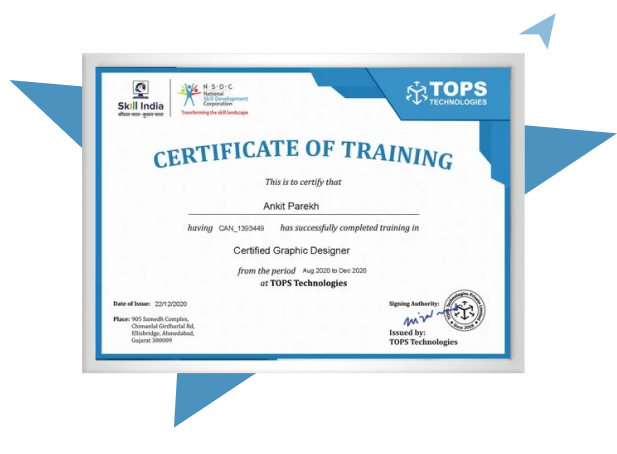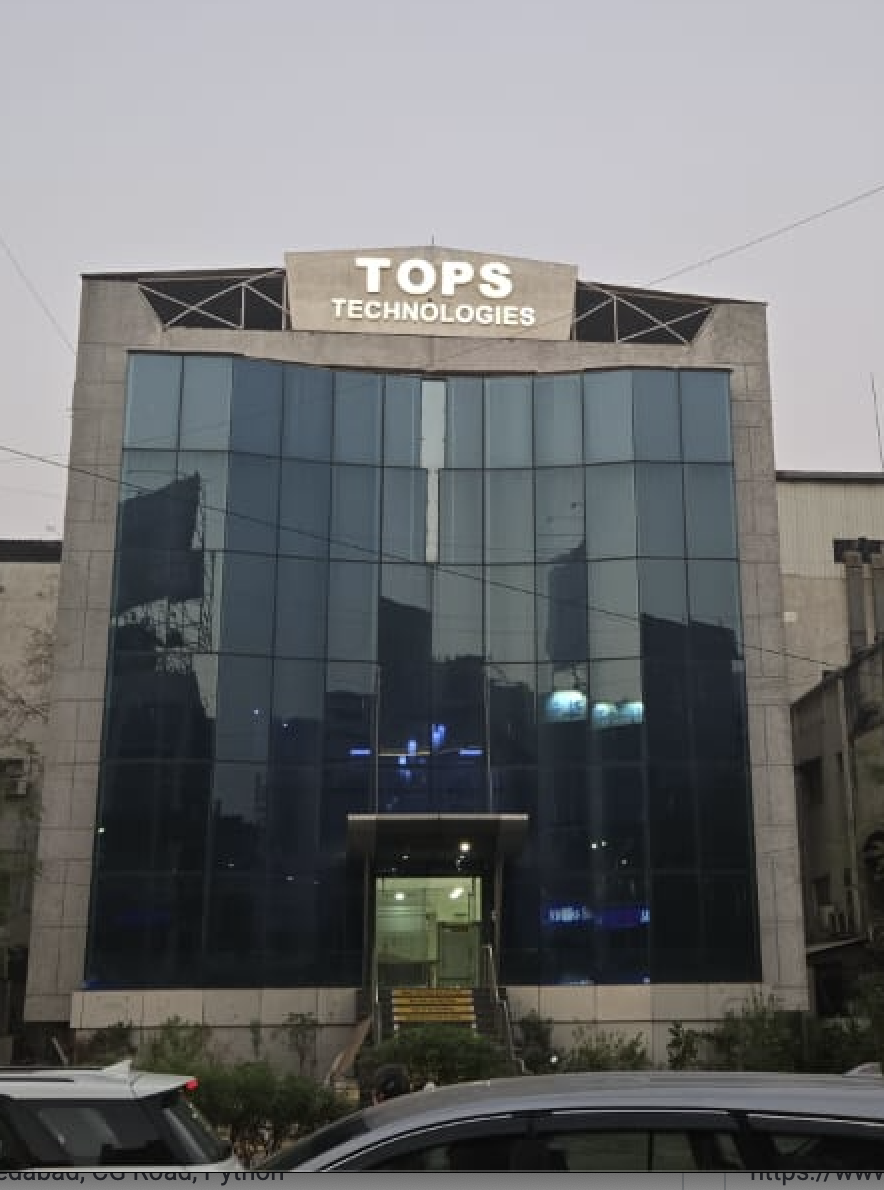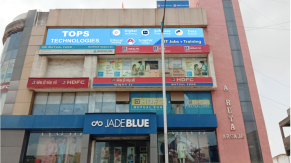Our Facts and Figures
1 Lac+
Student Placed
3000+
Companies TieUp
19+
Offices in India
50+
Industry Courses
Get 100% Job Assistance by enrolling in Certified Internet Of Things Training
Key Highlights
Limited Students Batch
Personalised Attention
Highly Qualified Teachers
Flexible Batch Timings
Interactive Learning
Live Projects
Career Support
Job Oriented Training
IOT Course Highlights
Internet of Things Training Program for Students and Professionals
TOPS Technologies stands tall as one of the best IT training provider in Ahmedabad. Offering the best-in-class Internet of Things training in Ahmedabad, specially designed master in IoT language. This is extensively used by companies like IBM and Altiux as their main programming language for their products.
The high demand for IoT language in the IT industry ensures that it is the right to grab such an opportunity in the city. Pick the required skills for IoT Training in Ahmedabad and be the genius in working with appliances that can be governed and programmed to work according to commands. The expert trainers at TOPS Technologies Ahmedabad have their experience as their biggest asset. This makes it easier and fun for students to learn the IoT language just the way it is known in common parlance.
Students after completion of the course are expected to learn IoT with programming logic and also the advanced understanding of control for Raspberry Pi and Arduino software functions that will set up learners to get a job offer in leading IT companies. Get the knack over IOT language with TOPS Technologies experts and learn about exchanging the data between the connected devices, smart devices, sensors, software, and other things.
Over 10,000 students have redefined their careers with TOPS Technologies and gotten the best jobs in the IT industry. Take a constructive step towards your future by attending a risk-free demo at TOPS Technologies Ahmedabad Training Center and decide for yourself.
Our team is available to answer all your queries and concerns related to IoT certification in Ahmedabad. TOPS Technologies Ahmedabad Centers are located at C.G.Road, Maninagar, SG Road , Naranpura Bhuyangdev, & Ashram Road. Find your nearest training center and visit us for more details, career Counselling, and free-demo Whatsapp or Call us.
40%
Average Salary Hike
4.5 Lacs
Highest Salary
3000+
Hiring Partners
Join Our Free Upcoming Webinar
Graphic Design with UI / UX
19 Jul 2025, 11:00 AM
Trainer
Gaurav singh tomar
(Sr. Technical Trainer)
All About Full Stack Development
19 Jul 2025, 03:30 PM
Trainer
Rahul Sanghavi CG
(Sr. Technical Trainer)
Want to protect yourself against Malware
19 Jul 2025, 05:00 PM
Trainer
Parag Parmar
(Sr. Technical Trainer)
How to Find the Bug in Manual Testing
20 Jul 2025, 11:00 AM
Trainer
Rahul Sanghavi CG
(Sr. Technical Trainer)
How to Crack the TCS Interview
19 Jul 2025, 02:00 PM
Trainer
Nisarg Jani
(Full Stack Engineer at Cognizant, Ex. System Engineer, TCS)
IOT Course Curriculum
Download Curriculum- Introduction of IoT
- The Internet ofThings
- Introduction to Cloud Computation
- IOT Application of different domain
- Arduino Device
- Arduino IDE
- Connectivity With Serial Port
- Serial Output
- Device Connection With Arduino
- Device Controlling using Arduino Programming
- Variables
- Basic operation(add, subtract,multiply)
- Basic Variable type (string,integers)
- Concatenating String
- Booleans (True/False)
- Lists
- Lists Methods (Append, Extend)
- Adding Lists Together With +
- Sets
- FOR Loops
- Indexing
- Splitting Strings
- Tuples
- Dictionaries
- Working With Sensors
- PIR Motion sensor
- how to use Ultrasonic Sensor
- Work With DHT11 Sensor
- How to use Bluetooth Module(HC-05)
- Connect ESP8266 With Arduino For Wi-Fi Connectivity
- Connect Soil Moisture sensor With Arduino
- How Web Service Working
- Creating web service
- Fetching data in Arduino using web service
- Controlling device using web services
- MQTT
- DDS
- AMQP
- LoRa-WAN
- CoAP
- GSM
- Wi-Fi
- Establish Remote Desktop Connection
Our TOPS Training Centers in India
Get Training Certificate by Government
Recognized NSDC/Skill India

- National Skill Development Corporation
- Supported by the vision of PM Shri Narendra Modi
- Certification by NSDC SkillIndia
- Valid for all Jobs and College Training
- International Recognition

FAQ
Common IoT protocols include:
- MQTT (Message Queuing Telemetry Transport)
- CoAP (Constrained Application Protocol)
- HTTP/HTTPS
- LoRaWAN (Long Range Wide Area Network)
- ZigBee
- Bluetooth/BLE
- Wi-Fi and Cellular (3G, 4G, 5G)
MQTT is a lightweight publish-subscribe messaging protocol used for low-bandwidth and high-latency IoT networks. It’s widely used because it’s efficient, simple, and ideal for real-time communication between IoT devices and servers.
5G provides high-speed, low-latency connectivity, making it ideal for real-time applications like autonomous vehicles, remote surgeries, and industrial automation. It supports massive IoT deployments with faster communication and broader coverage.
Edge computing refers to processing data near the source (on the device or gateway) rather than in a centralized cloud. It reduces latency, conserves bandwidth, and ensures faster decision-making in critical scenarios.
Wi-Fi is ideal for high-data, short-range applications like video streaming, while ZigBee is used for low-power, low-data-rate, and mesh networking applications like smart lighting and home automation.
IoT automates lighting, temperature control, security systems, appliances, and energy usage. Smart devices like Alexa, Google Nest, and smart plugs enable remote control and real-time monitoring of your home environment.
IoT is revolutionizing healthcare through remote patient monitoring, smart wearables, medication dispensers, and telehealth systems. It enables real-time health tracking and early diagnosis, improving patient outcomes.
IIoT refers to the use of IoT in industrial settings for predictive maintenance, supply chain optimization, asset tracking, and automation. It improves efficiency, reduces downtime, and enhances operational safety.
IoT in agriculture includes smart irrigation systems, crop health monitoring, weather forecasting, and automated farm machinery. It helps increase yields, conserve resources, and make data-driven decisions.
Anyone with a basic understanding of programming or electronics can enroll. It is ideal for students, working professionals, engineers, and tech enthusiasts who want to explore the world of smart technologies and embedded systems.
Interview Questions
IoT faces several technical and operational challenges, including:
- Security vulnerabilities, due to weak device authentication and lack of updates
- Privacy concerns, as personal and sensitive data is continuously collected
- Interoperability issues, where devices use incompatible protocols or standards
- Scalability, as managing thousands or millions of devices becomes complex
- Power and connectivity limitations, especially for remote or battery-operated devices
- Overcoming these challenges is vital for successful and secure IoT deployment.
An IoT platform is a comprehensive software solution that enables the management, integration, and operation of IoT devices and data. It provides tools for connecting devices, storing and analyzing sensor data, implementing security protocols, and creating applications. These platforms reduce development time and complexity by offering ready-to-use services such as data visualization dashboards, real-time alerts, and cloud infrastructure, enabling organizations to build scalable IoT solutions efficiently.
IoT devices continuously generate massive volumes of data from sensors and connected objects. Big data technologies are used to store, manage, and analyze this information to uncover patterns, predict behavior, and optimize processes. For instance, in smart cities, big data analytics helps monitor traffic flow, predict congestion, and improve infrastructure. Thus, IoT serves as a data source, while big data provides the tools to extract meaningful insights from that data.
Embedded systems are self-contained computing systems integrated into devices to perform specific functions, such as controlling a washing machine or a digital watch. They often operate independently and do not communicate externally. In contrast, IoT connects these embedded systems to the internet, allowing them to share data, be monitored remotely, and be part of a larger smart ecosystem. IoT adds connectivity, data exchange, and remote control capabilities to traditional embedded systems.
Interoperability in IoT refers to the ability of devices and systems from different manufacturers to connect, exchange data, and operate together seamlessly. It ensures that smart devices, platforms, and services can function in harmony, regardless of brand or protocol. This is crucial for creating scalable, flexible, and user-friendly IoT environments, such as smart homes or cities where devices from different vendors must work together reliably.
A gateway in an IoT system functions as an intermediary between local devices and the cloud. It collects data from multiple IoT sensors and devices, preprocesses the information to filter or compress it, and securely transmits it to cloud servers. Additionally, gateways manage different communication protocols, handle device authentication, and can perform local decision-making when cloud access is unavailable—thereby improving the system’s reliability and performance.
AI plays a crucial role in making IoT systems intelligent and autonomous. By applying machine learning algorithms to the data collected from IoT devices, AI can identify patterns, detect anomalies, and make predictions. This enables features like predictive maintenance in factories, smart energy management in buildings, and personalized automation in homes. AI helps IoT systems learn from data and make decisions without human intervention, greatly enhancing their usefulness and efficiency.
IoT is used across various sectors to automate tasks, monitor conditions, and improve efficiency. Common applications include:
- Smart homes: Automated lighting, thermostats, and security systems
- Healthcare: Wearable devices for patient monitoring and health tracking
- Agriculture: Smart irrigation and soil monitoring for better crop management
- Manufacturing: Predictive maintenance and real-time equipment tracking
- Smart cities: Traffic management, energy-efficient lighting, and waste collection optimization
- These examples show how IoT improves everyday life and industrial operations.
LoRa (Long Range) is a wireless communication technology designed for long-distance data transmission using low power. It is ideal for IoT applications where devices need to communicate over several kilometers without frequent battery replacement. LoRaWAN (LoRa Wide Area Network) is the protocol layer that manages communication between devices and gateways. It provides secure data transmission, device authentication, and efficient network scalability for smart agriculture, environmental monitoring, and smart city applications.
APIs (Application Programming Interfaces) are essential for enabling communication between IoT devices, platforms, and applications. They define how software components should interact, allowing developers to access sensor data, control devices remotely, and integrate services like analytics or notifications. APIs make IoT systems modular and interoperable, allowing developers to build custom applications, automate workflows, and connect IoT solutions with third-party services or enterprise systems.










